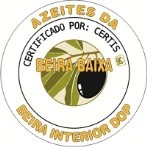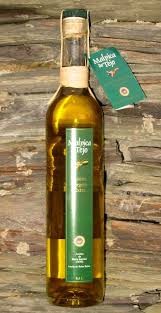Description: Extra virgin olive oils and virgin olive oils, made from the olives varieties Galega, Verdeal Cobrançosa e Cordovil, but grown in two different areas, Beira Baixa and Beira Alta.
Production method: The olives are cleaned and washed, after the harvest and transport to the mill.
After occurs the olives crushing and the resulting paste is then pressed (the temperature must be between 25 and 30 °C).
Olive oil separation by centrifuging or decanting depends on whether the classic or continuous method is to be used.
The olive oil is stored in either stainless steel or fiberglass resin container at a temperature of between 14°C and 18 °C.
At the end, the olive oil is bottled in inert recipients, after the filtration process.
Distinctive features: Azeites da Beira Interior PDO olive oil has a low to very low level of acidity.
The main olive variety used is Galega, that makes the color varies from a yellow green to yellow hints of green. This fruit is also responsible for the typical aroma and a fruity taste of the olive.
Production area: The geographic area is circumscribed to the concils of Meda, Figueira de Castelo Rodrigo, Pinhel, Guarda, Celorico da Beira, Seia, Gouveia e Almeida, and also, Sabugal, Covilhã, Belmonte, Fundão, Penamacor, Idanha-a-Nova, Castelo Branco, Vila Velha de Rodão, Sertã, Vila de Rei and Mação.
History: In the book Ensaios: Sobre história de Portugal, by Vitorino Magalhães Godinho is refered the wealth of olive oil in Beira Interior. The same book relates the destruction of many olive orchards on the Independence war, was then replanted in Beira Baixa on 1668. The oil went on to became very successful, especially in northern Europe, to the extent that in the 18th century it represented one sixth of Portuguese exports from the ports of Lisbon and Porto.
Product specification (pdf)

Producer group
APABI - Associação de Produtores de Azeite da Beira Interior
Control and certification body
CERTIS - Controlo e Certificação, Lda
Control plan
Control plan (pdf)
Publication in EU official journal
Reg. (CE) n.º 1107/96 - L290 13.11.1996
Reg. (CE) n.º 1107/96 - L148 21.06.1996
Publication in the Portuguese official journal
Despacho n.º 59/94, de 3 de fevereiro
Aviso n.º 4603/2000 (2ª série) 26.01.2000
Aviso n.º 4173-D/2005, de 10 de fevereiro



